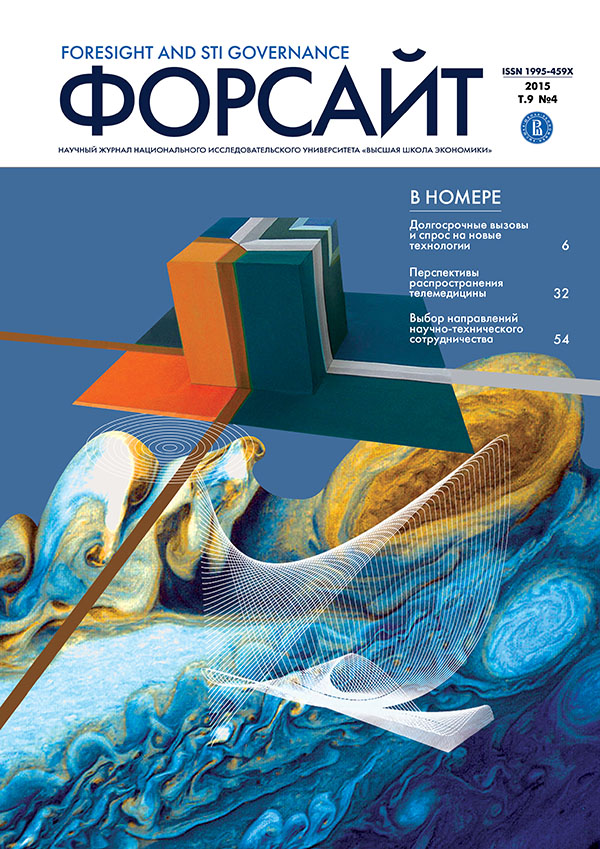Аннотация
По прогнозам экспертов, в большинстве стран мира продолжится рост государственных расходов на здравоохранение. Оптимизации этих затрат в долгосрочной перспективе будет способствовать распространение телемедицины — дистанционного медицинского обслуживания на основе информационных и коммуникационных технологий (ИКТ). Среди основных преимуществ телемедицины — снижение количества врачебных ошибок, экономия времени пациентов и врачей, повышение эффективности медицинских учреждений, своевременное и качественное обслуживание значительных сегментов населения, проживающих на географически отдаленных территориях с непростыми социально-экономическими условиями, в частности сельских.
В статье на примере сельских районов США представлен прогноз темпов распространения телемедицины с использованием модели Басса. Эта модель считается достаточно универсальной, так как апробирована на широком спектре продуктов и услуг, но имеет свои ограничения, поскольку носит оценочный характер и предполагает допущения в отношении отсутствующих данных. В случае телемедицины погрешности при расчетах обусловлены многочисленными барьерами для ее распространения, включая, например, высокие затраты на создание и эксплуатацию высокотехнологичного оборудования, недостаточную готовность врачей осваивать новейшие технологии и возможную неудовлетворенность пациентов качеством дистанционных медицинских услуг.
Литература
ATA (2015) Telemedicine/Telehealth Terminology. Washington, D.C.: American Telemedicine Association. Режим доступа: http://www.americantelemed.org/docs/practice-telemedicine/glossaryofterms.pdf, дата обращения 12.06.2015.
Bass F.M. (2004) Comments on A New Product Growth for Model Consumer Durables // Management Science. Vol. 50. № 12. Р. 1833-1840.
Bass F.M., Trichy K., Jain D.C. (1994) Why The Bass Model Fits Without Decision Variables // Management Science. Vol. 13. № 3. Р. 203-223.
Bates D.W. (2002) The quality case for information technology in healthcare // BMC Medical Informatics and Decision Making. Vol. 2. № 7. Р. 1-9.
CMS (2012) National Health Expenditure Data. Baltimore, MD: Centers for Medicare & Medicaid Services. Режим доступа: http://www.cms.gov/Research-Statistics-Data-and-Systems/Statistics-Trends-and-Reports/NationalHealthExpendData/downloads/tables.pdf, дата обращения 02.04.2015.
Casalino L., Gillies R.R., Shortell S.M., Schmittdiel J.A., Bodenheimer T., Robinson J.C., Rundall T., Oswald N., Schauffler H., Wang M.C. (2003) External incentives, information technology, and organized processes to improve health care quality for patients with chronic diseases // JAMA: The Journal of the American Medical Association. Vol. 289. № 4. Р. 434-441.
Craig J., Patterson V. (2005) Introduction to the practice of telemedicine // Journal of Telemedicine and Telecare. Vol. 11. № 1. Р. 3-9.
Croteau A.M., Vieru D. (2002) Telemedicine adoption by different groups of physicians. Paper presented at the 35th Hawaii International Conference on System Sciences, IEEE Computer Society.
DePhillips H. (2007) Initiatives and Barriers to Adopting Health Information Technology: A US Perspective // Disease Management & Health Outcomes. Vol. 15. № 1. Р. 1-6.
EHTEL (2008) Sustainable Telemedicine: Paradigms for future-proof healthcare (A briefing paper, version 1.0). Brussels: European Health Telematics Association.
Field M.J., Grisby J. (2002) Telemedicine and remote patient monitoring // JAMA: The Journal of the American Medical Association. Vol. 288. № 4. Р. 423-425.
Frist W.H. (2005) Shattuck lecture: Health care in the 21st century // New England Journal of Medicine. Vol. 352. № 3. P. 267-272.
Gagnon M.-P., Godin G., Gagné C., Fortin J.-P., Lamothe L., Reinharz D., Cloutier A. (2003) An adaptation of the theory of interpersonal behavior to the study of telemedicine adoption by physicians // International Journal of Medical Informatics. Vol. 71. № 2-3. Р. 103-115.
Hu P.J., Chau P.Y., Sheng O.L. (2000) Investigation of factors affecting healthcare organization’s adoption of telemedicine technology. Paper presented at the 33rd Hawaii International Conference on System Sciences, IEEE Computer Society.
Jha A.K., Ferris T.G., Donelan K., DesRoches C., Shields A., Rosenbaum S., Blumenthal D. (2006) How common are electronic health records in the United States? A summary of the evidence // Health Affairs (Millwood). Vol. 25. № 6. Р. 496-507.
Kijsanayotin B., Pannarunothai S., Speedie S.M. (2009) Factors influencing health information technology adoption in Thailand's community health centers: Applying the UTAUT model // International Journal of Medical Informatics. Vol. 6. P. 404-416.
Kuperman G.J., Gibson R.F. (2003) Computer physician order entry: Benefits, costs, and issues // Annals of Internal Medicine. Vol. 139. P. 31-40.
Makena R., Hayes C.C. (2011) Flexible Usage of Space for Telemedicine Systems, Man, and Cybernetics (SMC) // Proceedings of the IEEE International Conference. P. 1134-1139.
NQF (2010) Privacy: From Barrier to Enabler of Health Information Technology (HIT) // National Quality Forum Brief. № 18. Р. 1-6.
Norton J., Bass F. (1992) Evolution of Technological Generations: The Law of Capture // Sloan Management Review. Vol. 33. P. 66-77.
Ofek E. (2005) Forecasting the Adoption of E-books (Harvard Business School Exercise 505-063, May 2005). Boston, MA: Harvard Business School.
Ofek E. (2006) Forecasting the Adoption of a New Product (Harvard Business School Background Note 505-062). Boston, MA: Harvard Business School.
Ramos V. (2010) Contributions to the History of Telemedicine of the TICs. Paper presented at the Second IEEE Region 8 Conference on the History of Telecommunications (HISTELCON), 3-5 November.
Rao B., Lombardi A. II. (2009) Telemedicine: Current status in developed and developing countries // Journal of Drugs in Dermatology. Vol. 8. № 4. Р. 371-375.
Schoen C., Osborn R., Huynh P.T., Doty M., Peugh J., Zapert K. (2006) On the front lines of care: Primary care doctors' office systems, experiences, and views in seven countries // Health Affairs (Millwood). Vol. 25. № 6. Р. 555-571.
Stanberry B. (2000) Telemedicine: Barriers and opportunities in the 21st century // Journal of Internal Medicine. Vol. 247. № 6. P. 615-628.
Tan J., Cheng W., Rogers W.J. (2002) From Telemedicine to E-Health: Uncovering New Frontiers of Biomedical Research, Clinical Applications & Public Health Services Delivery // Journal of Computer Information Systems. Vol. 42. № 5. Р. 7-18.
Trembly A.C. (2001) Federal Study Supports Telemedicine, But Health Insurers Remain Skeptical, National Underwriter // LifeHealthPRO, 16.04.2001. Режим доступа: http://www.lifehealthpro.com/2001/04/16/federal-study-supports-telemedicine-but-health-ins, дата обращения 12.04.2015.
Vo A., Brooks B.G., Farr R., Raimer B. (2011) Benefits of Telemedicine in Remote Communities & Use of Mobile and Wireless Platforms in Healthcare. Galveston, TX: University of Texas.
WHO (2010) TELEMEDICINE Opportunities and developments in Member States (Report on the second global survey on eHealth Global Observatory for eHealth series, vol. 2). Geneva: World Health Organization.

Это произведение доступно по лицензии Creative Commons «Attribution» («Атрибуция») 4.0 Всемирная.

